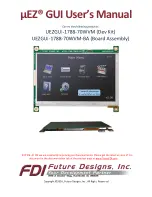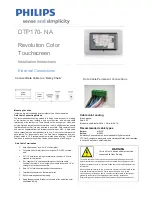
U E Z G U I - 1 7 8 8 - 7 0 W V M
U s e r ’ s M a n u a l
P a g e
|
11
3/20/2024
Copyright ©2024, Future Designs, Inc
Revision 5
To create a new project, download the application, run the executable file, and follow the onscreen instructions. It
will create a demo project using an emWin example GUI that will provide basic peripheral functionality. The project
maker greatly speeds up the development process for new applications. Example projects are ready to be compiled
and programmed onto
EZ GUI hardware using the included J-Link debugger, with no extra project configuration
necessary.
12.
Software
μEZ®
takes its name from the Muses of Greek mythology. A Muse was a goddess who inspired the creation process
for the arts and sciences. Like its ancient Greek namesake, the
μEZ®
platform inspires rapid development by
supplying customers with an extensive library of open source software, drivers, and processor support - all under a
common framework.
μEZ®
development works on the premise of ”design once, reuse many times”. This provides an
open source standard for embedded developers to build upon and support.
μ
EZ®
allows companies to focus on
innovation and on their own value-added applications while minimizing development time and maximizing software
reuse.
The diagram below shows a typical embedded application stack.
μEZ®
has three primary categories of components
that help simplify embedded application development:
1.
Operating System Abstraction Layer (μEZ
®
OSAL)
2.
Sub-system drivers (μEZ
®
TCP/IP, μEZ
®
USB, μEZ
®
Driver)
3.
Hardware Abstraction Layer (μEZ
®
HAL)
The selection of an RTOS can be one of the most daunting aspects of an embedded system development. With
μEZ®
the primary features of common multi-tasking operating systems are abstracted, thus easing the transition to an
open source or low-cost RTOS. The
μEZ®
OSAL provides applications access to the following features in an OS-
independent fashion:
•
Pre-emptive multitasking
•
Stack overflow detection
•
Unlimited number of tasks
•
Queues
•
Semaphores (binary, counting, mutex)
The
μEZ®
sub-system drivers utilize the OSAL functions to provide protected access to the processor peripherals. The
sub-system driver API functions are typically protocol layer interfaces (TCP/IP, USB, etc) designed as high-level access
routines such as open, close, read, write, etc. where possible.
μEZ®
is ideally suited for Embedded Systems with standard features such as:
•
Processor and Platform BSPs
(Board Support Packages)
•
Real Time Operating System (RTOS)
•
Memory Management
•
NAND/NOR Flash
•
SDRAM and DDR Memory
•
TCP/IP stack
•
USB Device/Host Libraries
•
Mass Storage Devices
•
LCD Displays with Touch Screen
•
Input / Output Devices


































